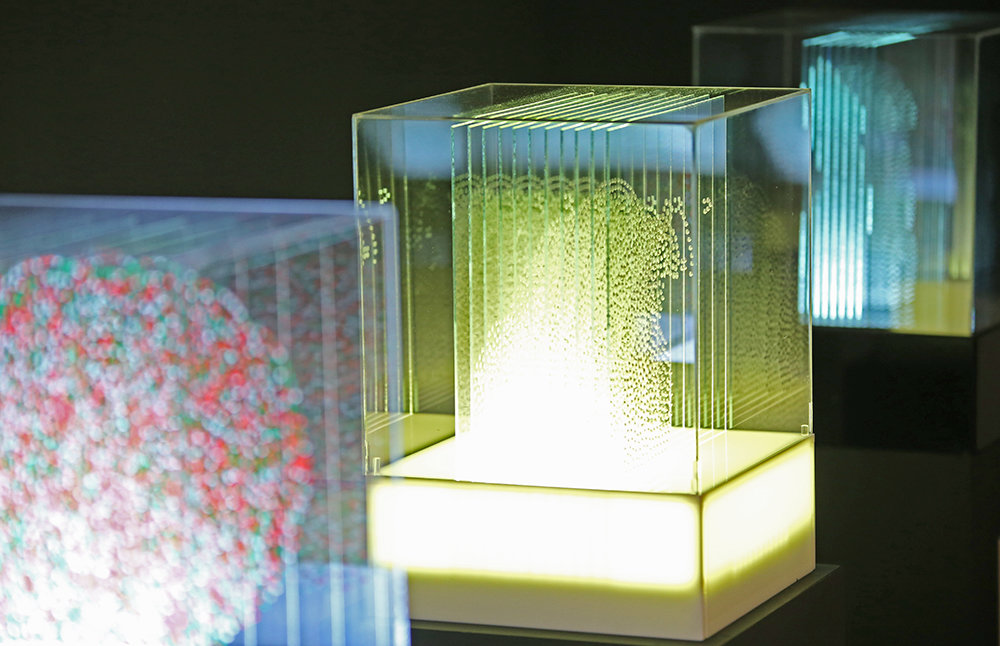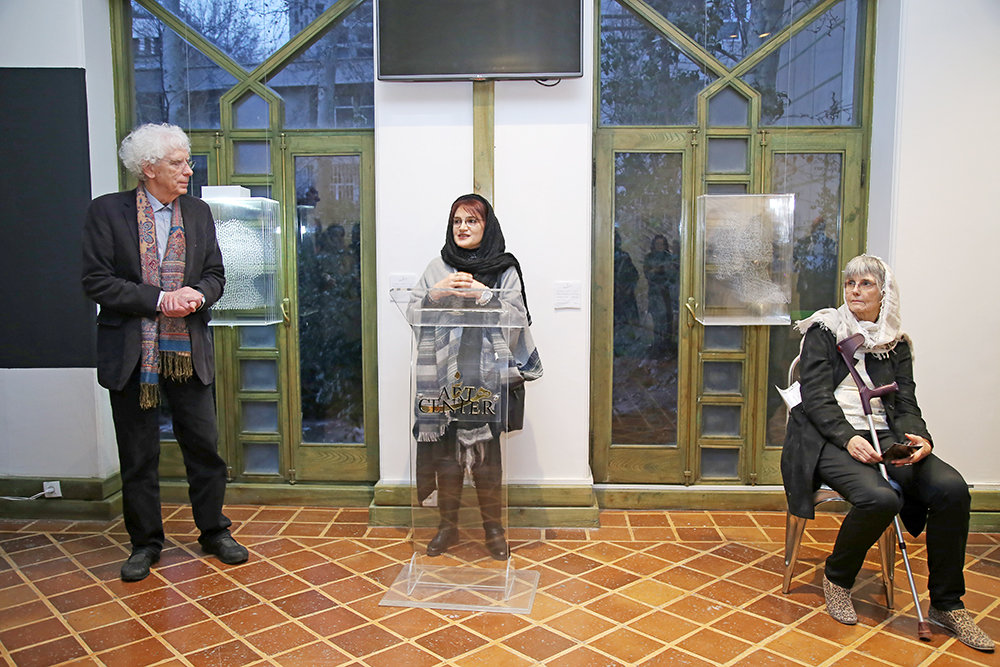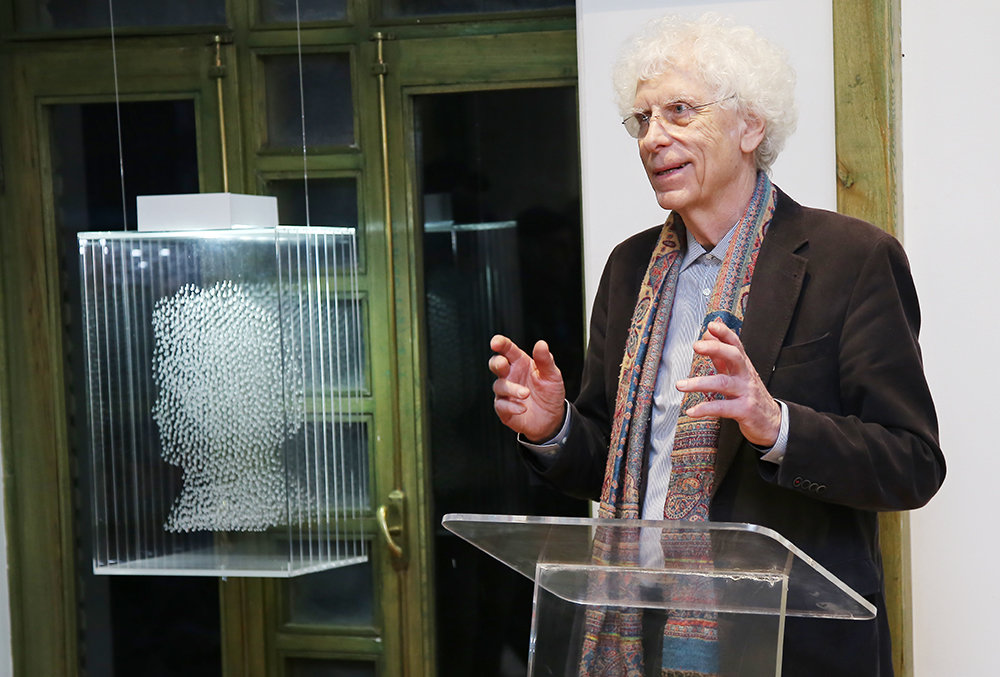German artist couple astonish visitors with perforated layers of glass

TEHRAN – Perforated layers of glass all set one after the other in window sets seem quite fascinating for the visitors, adding more to their fantasy is when one finds out the objects are made by handmade computers and machines.
Body figures plus busts of Beethoven and Goethe on one side and the growing stalagmites on the other add more taste to the exhibition of the German artist couple Ingrid and Knut Reinhardt who have displayed their works at the Art Center in Tehran.
Knut as a technician and Ingrid as an architect have tried to connect science with art in their young art, which they call “robart”.
“The starting point was the admiration for the artistic work of the Australian Aborigines, which is composed of point and line structures. We saw the art of the Aborigines on a trip we made to Australia 15 years ago to visit our relatives,” Ingrid told the Tehran Times in an interview done at the Art Center just before the opening of their exhibit on Friday.
“The Aborigines made art with points. Everything appears as if it is seen from above. They show something they have experienced, and for us, it was a kind of modern art, although it is a very old art. I also think it has a kind of connection to calligraphy because they have special signs to tell stories,” she added.
She said that the experience was the main starting point of their art. “I have studied architecture and have made sculptures but colors dripping on surfaces was the source of inspiration for robart,” she explained.
“My husband is a technician. He said we can do this [art of Aborigines] by means of a computer. He started to develop a special machine that could do this dripping. And we developed our own type of artworks with only acrylic colors to make our stalagmites,” she added.

German artist couple Knut (L) and Ingrid (R) attend the opening ceremony of their exhibition at Tehran’s Art Center on February 22, 2019 as an unidentified person is seen speaking in the photo.
The gracious lady Ingrid further explained, “I make sculptures with clay first, then we give it to the computer. The clay model is scanned to be further processed in a computer program. The programing is done by my husband who prepares the technical process for the robot. Then our personal machine named ‘Robart’ makes the motions visible on the monitor and coordinates the process. Then each layer is prepared for perforation.”
“The holes are made by the machines. And we use very special glass that has higher refraction. Of course it has to be done underneath water, otherwise the glass would break,” she remarked.
“My husband invented this machine to do that. The invention was his but we discuss the main ideas together and develop objects together,” she added.
The couple has already displayed their works in France and Belgium, and this is their third exhibit in Tehran, however, the couple visited Tehran previously.
An artwork featuring a bust of Beethoven is a highlight of the collection showcased at the exhibit.
“The Beethoven bust here on display has been implemented by several Iranian craftsmen. The holes look like music notes on layers of plexiglass. We gave the craftsmen the program and they produced the work. They had laser machines that we don’t have, so they used our program, perforated the layers of plexiglass and made the bust,” she said with a surprise in her voice.
She also said that the visitors are extremely fascinated when they examine the works closely, because it is very difficult to take photos of the objects.
“They do not really appear as what they really are on the catalogue. So we can explain it more easily when the visitors come and see in person,” she added.
The collection also boasts an artwork titled “Homa”, which has been created based on a stone statue of the Persian mythical bird Homa located in the ruins of the ancient city of Persepolis in Fars Province.

Knut Reinhardt speaks at Tehran’s Art Center on February 22, 2019 during the opening ceremony of an exhibition displaying a collection he has created along with his wife Ingrid.
Other highlights include a ball made with colorful shiny drops, impressions of insect wings and their personal perception of Semiramis, the queen regent of the Assyrian Empire.
The stalagmite artworks also appear to be a very different type of art. “Ren” depicting people running in different directions is a highlight of the stalagmite collection.
“We worked in China for few years as teachers. I was never able to learn Chinese. I learned a little bit of the language but there are some very expressive characters of the Chinese calligraphy and one was Ren. We wanted to have something to show immigration, so we thought we would use the Chinese character ‘Ren’, which resembles a person. And it was easy to do it with the machine. That is why we used it. The original Chinese symbols are really like pictures, and we were actually inspired by Chinese calligraphy,” she asserted.
On their intention to work on Persian calligraphy, Ingrid said that they need to first find interesting symbols in Persian calligraphy that are decorative and then develop the idea, which, of course, takes some time.
She next gave some details about their artworks created by dripping acrylic colors on huge surfaces, and how the huge machines do the drippings.
“First, comes the idea, then programs are made for the computer, then the huge machines begin the dripping process. The machines make the drops, and the drops continue until the idea we have planned appears on the surface,” she stated.
Asked if the dripping of colors can be done on the surface without the help of the machine, she replied, “This type of art can be done by ourselves too, but it can take a year, and the colors would not be applied perfectly. But with the machine it takes only three or four weeks.”
On her plan whether to teach or train any other students, Ingrid said that there have been people who are interested in their robart because the modern way to do art is by computer.
“I have been a teacher of art. I am 70, my husband is 75. We don’t have time to teach. We have a homepage and make exhibitions. People can come and watch what we do in our studios,” she concluded.
The exhibit will be running until March 5 at the Art Center located at North Salimi St., Andarzgu Blvd.
Photo: Artworks created by German artists Knut and Ingrid Reinhardt are on display at Tehran’s Art Center.
RM/MMS/YAW
